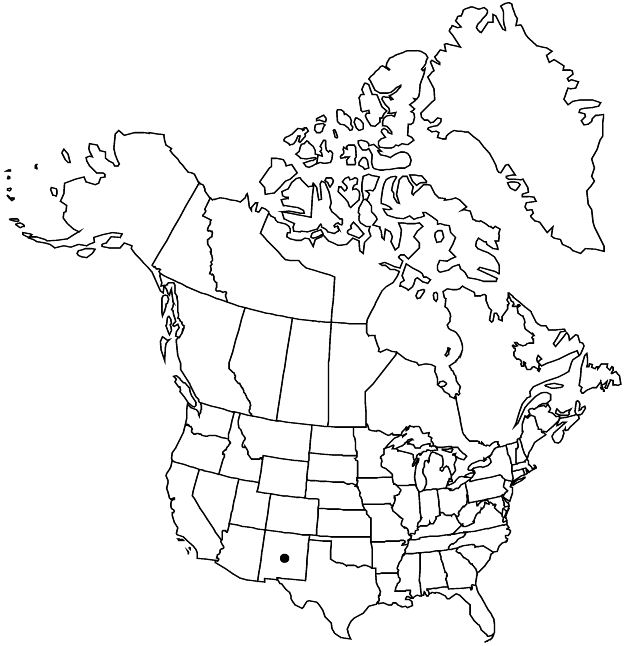Difference between revisions of "Potentilla sierrae-blancae"
in P. A. Rydberg, Monogr. N. Amer. Potentilleae, 2: 57, plate 18, figs. 3–5. 1898.
FNA>Volume Importer |
imported>Volume Importer |
||
| (6 intermediate revisions by 2 users not shown) | |||
| Line 1: | Line 1: | ||
{{Treatment/ID | {{Treatment/ID | ||
|accepted_name=Potentilla sierrae-blancae | |accepted_name=Potentilla sierrae-blancae | ||
| − | |accepted_authority=Wooton & | + | |accepted_authority=Wooton & Rydberg |
|publications={{Treatment/Publication | |publications={{Treatment/Publication | ||
|title=in P. A. Rydberg, Monogr. N. Amer. Potentilleae, | |title=in P. A. Rydberg, Monogr. N. Amer. Potentilleae, | ||
| Line 32: | Line 32: | ||
|distribution=N.Mex. | |distribution=N.Mex. | ||
|discussion=<p>Of conservation concern.</p><!-- | |discussion=<p>Of conservation concern.</p><!-- | ||
| − | --><p>Potentilla sierrae-blancae is restricted to the White Mountains, Lincoln and Otero counties. P. A. Rydberg (1898, 1908d) and B. C. Johnston (1985) placed P. sierrae-blancae in sect. (or group) Aureae; the species fits well in sect. Concinnae, combining the few-flowered inflorescence of P. angelliae with the tridentate leaflets of P. bicrenata and P. johnstonii.</p> | + | --><p><i>Potentilla sierrae-blancae</i> is restricted to the White Mountains, Lincoln and Otero counties. P. A. Rydberg (1898, 1908d) and B. C. Johnston (1985) placed <i>P. sierrae-blancae</i> in sect. (or group) Aureae; the species fits well in sect. Concinnae, combining the few-flowered inflorescence of <i>P. angelliae</i> with the tridentate leaflets of <i>P. bicrenata</i> and <i>P. johnstonii</i>.</p> |
|tables= | |tables= | ||
|references= | |references= | ||
| Line 41: | Line 41: | ||
-->{{#Taxon: | -->{{#Taxon: | ||
name=Potentilla sierrae-blancae | name=Potentilla sierrae-blancae | ||
| − | + | |authority=Wooton & Rydberg | |
| − | |authority=Wooton & | ||
|rank=species | |rank=species | ||
|parent rank=section | |parent rank=section | ||
| Line 56: | Line 55: | ||
|publication year=1898 | |publication year=1898 | ||
|special status=Conservation concern;Endemic | |special status=Conservation concern;Endemic | ||
| − | |source xml=https:// | + | |source xml=https://bitbucket.org/aafc-mbb/fna-data-curation/src/2e0870ddd59836b60bcf96646a41e87ea5a5943a/coarse_grained_fna_xml/V9/V9_268.xml |
|subfamily=Rosaceae subfam. Rosoideae | |subfamily=Rosaceae subfam. Rosoideae | ||
|tribe=Rosaceae tribe Potentilleae | |tribe=Rosaceae tribe Potentilleae | ||
Latest revision as of 22:55, 5 November 2020
Stems 0.2–1 dm, lengths 1–1.5 times basal leaves. Basal leaves palmate, 2–8 cm; petiole 0.5–5 cm, straight hairs sparse to abundant, sometimes absent, ± appressed, 2–3 mm, usually ± stiff, cottony hairs absent, glands absent; leaflets (3–)4–5, at tip of leaf axis, separate, proximal pair separated from others by 0(–1) mm of leaf axis, central leaflets narrowly cuneate-oblanceolate, 0.8–2.2 × 0.2–0.5 cm, petiolules 0(–1) mm, less than distal 1/4 of margins incised 1/2–3/4 to midvein, teeth 1(–2) per side, ± separate, 1–2 mm, surfaces similar, green, straight hairs mostly absent (except on margins), appressed, 1–2 mm, stiff, cottony hairs absent, glands absent, rarely sparse. Inflorescences solitary flowers or 2–3-flowered. Pedicels 1–4 cm. Flowers: epicalyx bractlets narrowly to widely elliptic-ovate, 2–3.5 × 1–1.5 mm; hypanthium 3–5 mm diam.; sepals 3–5 mm, apex obtuse to acute; petals 5–7 × 4–6 mm; filaments 1–2 mm, anthers 0.4–0.8 mm; carpels 5–20, styles 2 mm. Achenes 1.5 mm, smooth.
Phenology: Flowering summer.
Habitat: Windswept barren ridges, subalpine grasslands, rock outcrops
Elevation: 2400–3700 m
Discussion
Of conservation concern.
Potentilla sierrae-blancae is restricted to the White Mountains, Lincoln and Otero counties. P. A. Rydberg (1898, 1908d) and B. C. Johnston (1985) placed P. sierrae-blancae in sect. (or group) Aureae; the species fits well in sect. Concinnae, combining the few-flowered inflorescence of P. angelliae with the tridentate leaflets of P. bicrenata and P. johnstonii.
Selected References
None.
